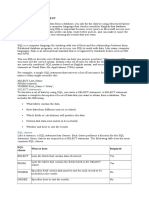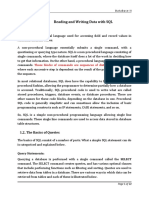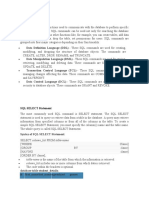0% found this document useful (0 votes)
6 views2 pagesOrder of Execution of SQL Query
The document explains the order of execution for SQL queries, detailing the sequence from the FROM clause to the LIMIT clause. It emphasizes the importance of understanding this order for writing efficient queries. A mnemonic is provided to help remember the order of execution: 'Fast weasels gracefully Having, silently over leaves.'
Uploaded by
sunil.bellalaCopyright
© © All Rights Reserved
We take content rights seriously. If you suspect this is your content, claim it here.
Available Formats
Download as DOCX, PDF, TXT or read online on Scribd
0% found this document useful (0 votes)
6 views2 pagesOrder of Execution of SQL Query
The document explains the order of execution for SQL queries, detailing the sequence from the FROM clause to the LIMIT clause. It emphasizes the importance of understanding this order for writing efficient queries. A mnemonic is provided to help remember the order of execution: 'Fast weasels gracefully Having, silently over leaves.'
Uploaded by
sunil.bellalaCopyright
© © All Rights Reserved
We take content rights seriously. If you suspect this is your content, claim it here.
Available Formats
Download as DOCX, PDF, TXT or read online on Scribd
/ 2




























































































